I'm waiting for the phone to ring for having taken these pictures earlier this afternoon, as citizens of Mount Hope describe my suspicious activities to the authorities.
By Mark Fenton
Published February 14, 2008
In July of 2007 I was witness to a motor-vehicle accident in Mount Hope, Ontario, roughly a 40 minute walk from where I work. I had just pulled off of Highway 6 onto Homestead Drive (Mount Hope's main street) continuing to follow the taxi in front of me at about six car lengths. A Camry pulled out from in front of the Post Office on Homestead, making a U-turn in front of him. I saw the Camry. The taxi didn't.
I still don't believe the cab or I were going that fast. Given that fact I was astounded to see the taxi hit the Camry's front end without slowing at all. Perhaps it's a question of not being able to process a jolt you aren't expecting, but rather than brake, the cab driver swerved across the road, broke through a barbed wire fence, and stopped in a field some 50 feet beyond the crash, luckily without hitting a tree.
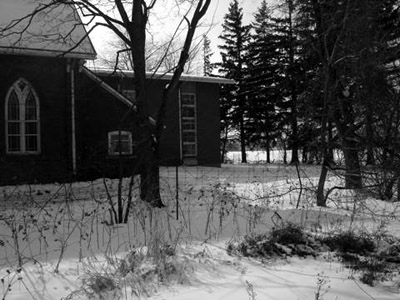
Given the amount of time that I spend in random public space, readers will be happy to know that I am now certified in first aid.
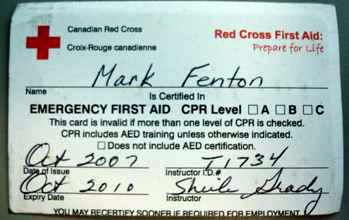
Back then I wasn't though, so I'm sure glad there were no injuries. Belts had been worn by both parties. No blood, no cranial impact, no lost consciousness. I may have been the only one who actually saw the impact, but this was irresistible public excitement in the heart of Mount Hope, and immediately following the crash there were a whole lot of other people on the scene.
Being the primary witness to the accident I was obligated to wait for the police. An unusual role for me. Usually it's The Finest who come looking for me, given that I take photographs in places no one has any business taking photos and it seems I'm naturally suspicious to start with.
In fact, as I write, I'm waiting for the phone to ring for having taken these pictures earlier this afternoon, as citizens of Mount Hope call the authorities, describe my suspicious activities, and quote my licence plate.
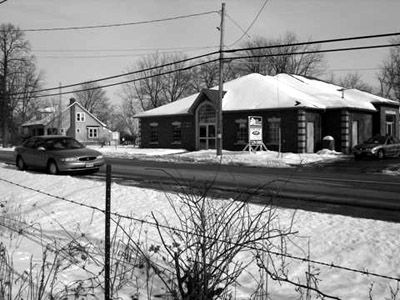
You can see the top line of barbed wire that the car passed under, and they still haven't repaired the lower lines that the car tore out. This is where I stood after checking on the cab driver to see if he was OK. He was. He clearly wanted me away from him, so I went back to the point of the collision.
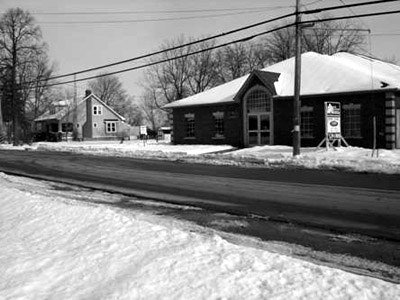
The driver of the Camry exited the car immediately after the crash, and began running madly back and forth between the cab and her own car expressing the usual anxieties around fault and expense and insurance. (This reaction was pretty much diametrically opposed to the cab-drivers reaction, which stuck me at the time as an interesting dialectic of coping strategies.)
I did my best to calm her down by spouting the conventional pieties of how we should all just be thankful no one was hurt. That helped more than I might have expected. Just having someone to talk to stopped her from running around in circles, which I think was healthy.
My position as counsellor was then usurped by a local who was more certain of everything that had happened than I was of anything. With regard to fault he had already taken a side and it was hers. He remarked how people come off the highway like maniacs and the cab must have been going at least 100 km/hour to have ended up as far from the crash as it did.
He hadn't seen the accident. I had. And I had maintained a constant distance behind the cab along Homestead Drive which meant that if the cab had entered Mount Hope at a maniacal velocity and maintained this velocity that meant that I too had entered at and maintained a similar maniacal velocity, our two cars locked and buzzing through Mount Hope like copulating dragonflies. I was becoming less and less thrilled about my impending interview with The Finest.
When he arrived the officer immediately sensed my uncertainly and cut straight to questions that would elicit the ambiguities of inattention.
Finest: So how fast was he going?
Me: Well, I'm not sure...I mean... probably the speed limit.
Finest: Well how fast were you going?...You said you were behind him all the way from the Hwy 6 turnoff so your speeds should be close.
Me: Yeah...ahhh. The speed limit.
Finest: Maybe a bit over...?
Me. Maybe a BIT...
Finest: So could we safely say 60-65 kms/hr?
Me: Yeah...well...OK...sure.
It went on like this for a while.
Finest: And you say you THINK she was making a U-turn.
Me: Well. Yeah. You can see from the position of the car...
Finest: I can see the position of the car. Did she make a U-turn or did she pull out of the parking lot? You have to be careful what you say on a report. You see if this goes to court and the counsel questions you and you're not sure, it will discredit your testimony.
Me: Well...I mean...she definitely didn't see that there was someone in that lane.
Finest: Oh? So you were in the car with her?
I'm making him sound harsh. He was really quite friendly and approached my narrative like an editor trying to focus a neophyte author. You may have guessed that linear event reporting isn't what readers come to me for. He handwrote in pencil, and before committing each of the paragraphs he ghostwrote, he'd turn to me with a "So could we safely say..."
In the end I felt it was more his narrative than mine, but that's how I always feel with collaborative writing. He took down my phone numbers. So far no one has called me about the incident.
All my stories begin with a place. As I stood in the snow photographing the location of the accident from half a year ago, trying ineffectively not to be noticed, I pondered what I believe is a universal feeling that places retain a residue of events that happen in them.
There are many ways of describing it. People speak of the energy from previous owners—be it positive or negative - in a house they move into. I've often heard survivors of political cruelty say that they needed to return to the site of their abuse, as though they need a material reference from which to begin their recovery.
Is it not significant that many of the architectural firms that submitted plans for a new World Trade Centre proposed a structure that would surround and leave empty the footprint of the destroyed buildings?
The most lurid example I know of the power of places to retain the vestige of trauma is M. Night Shyamalan's film The Sixth Sense. The child in the film, whenever he inhabits spaces in which violent deaths have occurred, actually sees the victims walking around zombie-like in their gore. Who can forget the spine-tingling moment when the kid, in a loud whisper reveals: "I see dead people... ALL THE TIME."
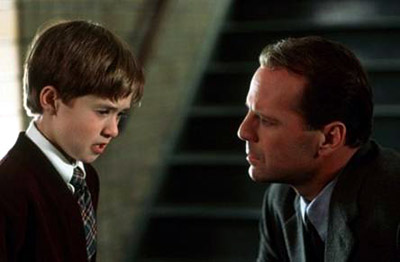
Which is scary if you heard it on screen first, but, like the shower scene in Psycho, pretty soon just becomes pop culture currency, with the meaning and fear exploded out of it.
But my favourite related quote is from the great English poet, Geoffrey Hill. It took me some amount of labour, but flipping through my paperback collection of Geoffrey Hill's early poetry I eventually came upon these lines, which describe the essence of violent conflict that lingers after combat.
A field
After battle utters its own sound
Which is like nothing on earth, but is earth.—from Funeral Music
DIGRESSION ON THE DECLINE OF PRINTED TEXT AND AUTHOR PHOTOS
I was really stuck in my research. I couldn't remember the title of the poem it came from and couldn't summon up enough of the quote to Google it. Aside from book length works like The Iliad or The Divine Comedy I've all but stopped reading poetry in books. For short lyric poems it's so much easier to simply type a line you know from memory into a search engine, read it on the screen, and put all your poetry into boxes for the attic so you can fill your empty book-shelves with knick-knacks.
However, I didn't have enough consecutive words to find it this way, so I had to run home and get my volume of Hill's early verse, which was in the attic, in a box. There was something satisfying about that. Atavistic but strangely moving. That actual ink embedded in the paper just as the human cost of battle is embedded in the earth. Here's how the paper looked as I read it
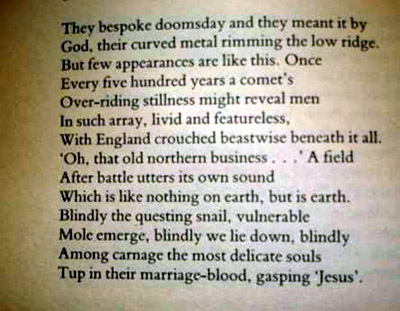
and I'm only ostensibly reproducing it for the effect of the paper. Really, this stuff is so powerful I feel the words being chiseled onto the back of my brain every time I read them.
Found and photographed I tossed the book quickly back in the box before subjecting myself to the perils of antiquated print matter: paper cuts, infection from the previous owner that the used sticker on the cover indicated it had had, and heaven knows what other risks.
Before I left it there though I took a quick shot of the author photo on the back cover:
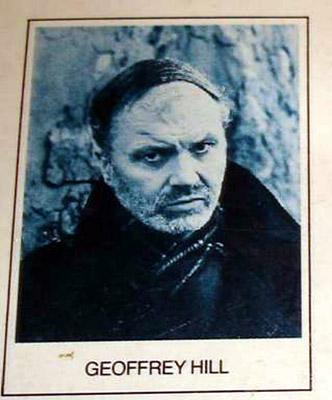
Intense, wool-clad, rebarbative. Standing before the rugged exterior of what is either a medieval castle or a convincing backdrop of one from the photo studio. The kind of man one could well believe "bespoke doomsday and meant it by God." Compare to this photo on a more recent volume
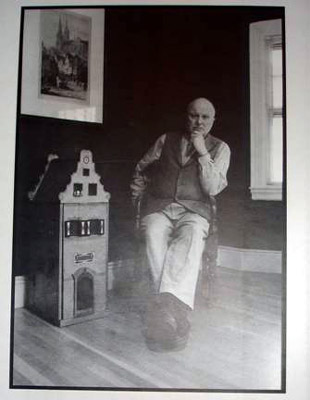
Can I just say that despite some dubious sartorial choices here I much prefer the buzz-cut Hill to the combed-over Hill. The photo of medieval buildings framed and indoors is also more inviting than the real thing. And I respond favourably to what I can only deduce is a doll's house built or purchased lovingly for some tot. We mellow with age.
END OF DIGRESSION ON THE DECLINE OF PRINTED TEXT AND AUTHOR PHOTOS
Naturally I am not comparing the accident site in Mount Hope to the dead on a battlefield or land that once supported a death camp. And in truth, as I stood there, I felt none of the anxieties of that day in July. I just have a need to impose meaning on what often feels like a life of meaningless events.
Finished with the pictures I began my walk back through Mount Hope to the airport. As I took a shortcut behind the convenience store at Homestead and Airport Road I was struck by this exterior painting.
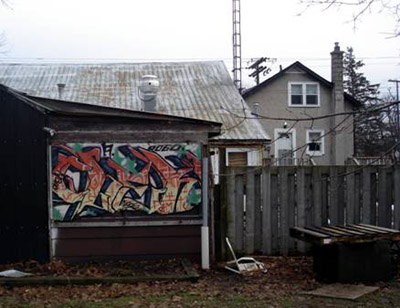
Three provocative—dare I say "academic" — queries formulated themselves.
1 Mount Hope, while now officially part of the City of Hamilton, has existed for years as part of the Glanbrook Township, which at the 2006 census, collectively boasted a population of 15,293. Question: Given that this kind of artwork is now appearing in sparse communities in the borderlands of commuter sprawl and agricultural land, just how ‘urban' is urban art? In a post-internet world are distinctions of urban and rural still meaningful? Discuss.
2 Is it just me or does that artwork occupy a clearly delimited rectangular space so perfectly that one feels it must have been commissioned. Note the spot-lighting at the top left corner (serving rather like those lights attached to garish picture frames to illuminate what are usually equally garish paintings within). Compare and contrast with Jackson Pollock's 1943 mural for Peggy Guggenheim.
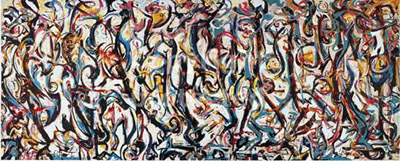
Jackson Pollack, Mural, 1943
So fixated was Ms. Guggenheim on the work fitting perfectly into a space in her apartment that a portion was cut from it and lost to history. Might one argue that what I'll entitle, for the sake of convenience, "Mount Hope Urban,"
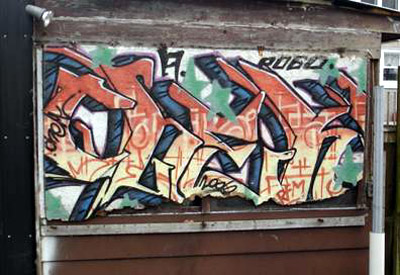
fills the space WITHOUT a sense of amputation ? Discuss.
3. If the painting hasn't been amputated deliberately, the lower edge has clearly fallen foul to the elements, forming an organic "tear" to its bottom edge. Consider this accidental assault on the work's integrity with Duchamp's large glass
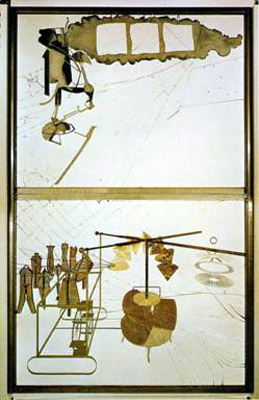
Marcel Duchamp, The Bride Stripped Bare by her Bachelors, Even (The Large Glass) 1915-1923
after it was dropped in transit and which "cracking" Duchamp hailed as an improvement on his original. With this in mind, does Mount Hope Urban gain or lose from the inadvertent modification of entropy? Discuss.
Should any of you art history or multi-disciplinary humanities professors wish to use any of the above as exam questions, go right ahead. Please don't hit my E-mail for permission. I will not have time to respond to all of you individually.
THIS is weird. It was just hanging there as I walked past.
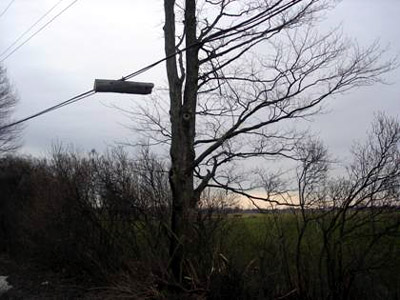
Did it come off a tree? Did it blow up there in the wind? Is it an adolescent prank like sneakers over the power lines? Look how precisely horizontal it is. Cylindrical. In sculptural power and execution there is an obvious parallel with the mobiles of Alexander Calder.
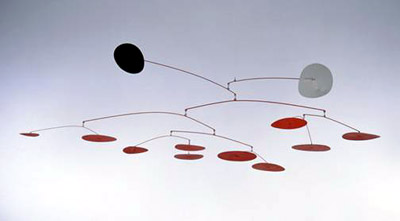
Alexander Calder Black, White, and Ten Red, 1957 National Gallery of Art, Washington D.C.
whose determination to suspend objects in mid-air only proves how persistently all material objects want to succumb to gravity.
Despite being urged by this strange
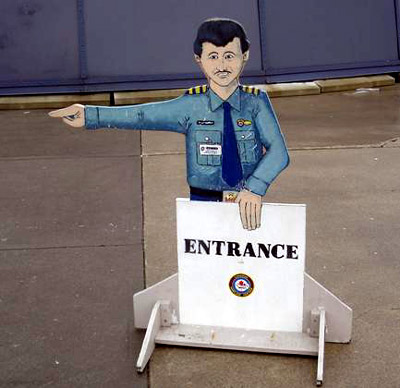
small man, into the dark canopy of killing machines known as the Canadian Warplane Heritage Museum
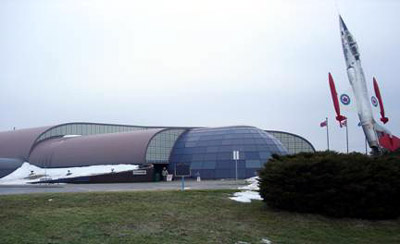
I hurried past instead into the parking lot of the John C. Munro International Airport, which to my surprise was the most sublime station on my journey.
THE JOHN C. MUNRO GARDEN OF ACCIDENTAL ICE SCULPTURES
They were ornate and they were everywhere. I am not a meteorologist but I believe they were formed by some unsettling combination of snow-fall, rain, melting, freezing, melting, refreezing, melting, refreezing...
The first ones I saw
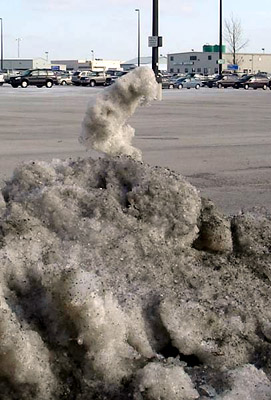
were like vultures
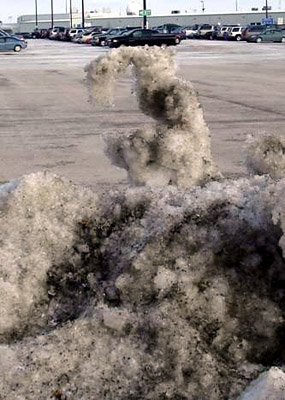
perched and awaiting the carrion of a failing civilization. Ice, snow, or some indeterminate substance between the two, their surface had been given a compelling chiaroscuro thanks to auto emissions. Duchamp ready-mades without the pretension. These first could perch alongside the gargoyles of Notre-Dame de Paris
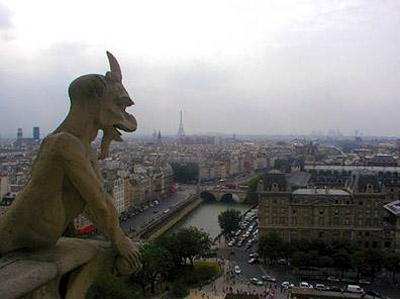
while this one
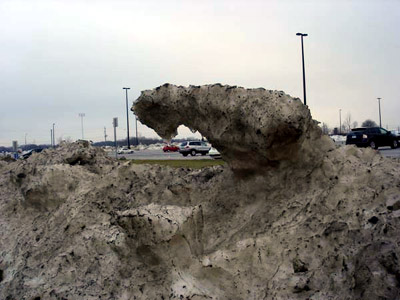
is post-industrial, a dead ringer for the streamlined, deco-gargoyles that adorn The Chrysler Building in New York.
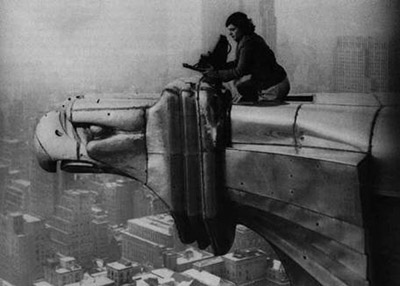
It was late January, yet snow was melting everywhere I looked. And all of it was snakelike, malformed, malignant
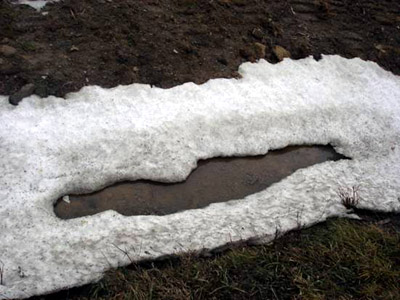
I have lived all my life in Canada and half of it on the prairies. Yet these angular, burrowing, piercing and twisted meltings were new to me. Perhaps the Inuit, or the Icelanders - both cultures said to have dozens of words for varieties of snow - have a name for this stuff, but I don't.
Surely scientists have names for odd vertical snow/ice formations, just as there are names for odd vertical rock formations like Hoodoos:
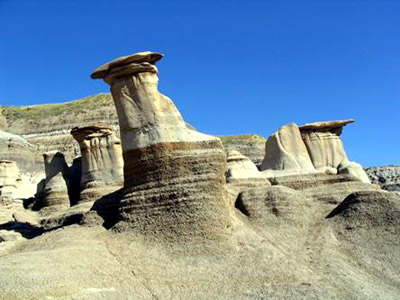
and bugaboos
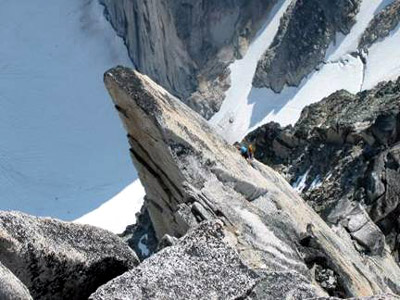
But I could only read these creatures as a diseased product of Global Warming, a.k.a. Climate Change, a.k.a Climate Chaos. A twisted metaphor for elastic temperature shifts the region isn't supposed to have to deal with.
I walked back along the approach to the airport. Motorists whizzed by me, already on cell phones to security. On second glance these forms were no longer demons and ghouls. They were victims
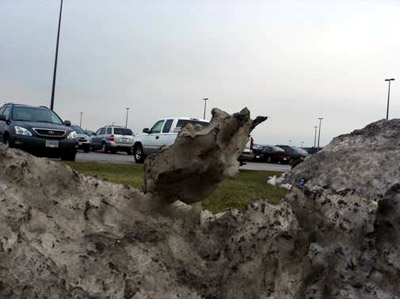
frail, open-mouthed and screaming.
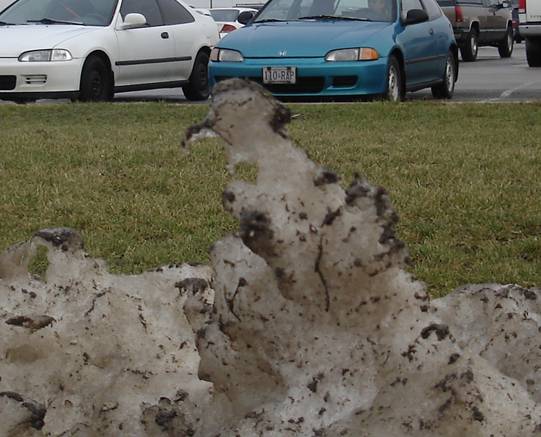
on the verge of breaking off and melting to oblivion. I thought of scattered lines from "Tenebrae," by the great German language poet and holocaust survivor, Paul Celan.
...Wind-awry we went there,
Went there to bend
Over hollow and ditch.
To be watered we went there, Lord.[...]
Our eyes and our mouths are so open and empty...
—From Tenebrae: translated by Michael Hamburger
I got out of there and walked uneventfully to my destination. Like Lisa in Max Ophüls' great film Letter from an Unknown Woman I have always enjoyed winter walks to summer ones. I'm paraphrasing, but it is winter in Vienna and Stefan, charmer that he is, says something to the effect of how it would be nicer if it were summer with all the flowers blah blah blah and Lisa says something like how she prefers taking walks in the winter because in the summer there's nothing to imagine.
DIGRESSION ON A FAVORITE MOVIE: Letter From An Unknown Woman, Max Ophüls, 1948.
I get a little ecstatic about this movie, and have recommended it to friends in wildly hyperbolic terms like: "The greatest film ever to come out of a Hollywood studio." And so naturally when friends go out and watch it it's ultimately disappointing after my build-up.
The screenplay is based on a short story by Stefan Zweig, a Viennese author popular in the first decade of the 20th century. If not influenced by the early writings of Freud his stories are certainly steeped in the zeitgeist that produced Freud. Characters are driven by neurotic obsessions which usually have their origins in the pleasure principal, and which they follow to dire consequences under the prurient gaze of Viennese society.
In Ophüls' film Stefan (Louis Jordan), a successful and famous writer, is reading a letter from Lisa (Joan Fontaine). He can't place her (writers sleep with so many women I guess that they can't keep them straight) but it seems that years earlier they had a one night stand from which she became pregnant and had a child.
The night he can't remember; the night she can't forget. She loves him with a passion everlasting, so self-sacrificing that she never wanted to upset him by letting him know about his child. Irked and frustrated he might pull his hair

and that would be messy with all that product. Passionate man that he is, as he learns of her fate he works himself into a frenzy ("How COULD I be so self-absorbed and callous" his extreme gestures tell us as he reads. Though darned if he can remember her).
The affair itself is shown in flashbacks. I know it sounds like stock romance, but don't judge until you've seen some Ophüls. Ophüls was Austrian Jew who made a series of films in Vienna before fleeing for Hollywood during the Hitler years and making four movies of which Letter from an Unknown Woman is probably the best.
After the war he settled in Paris and made his final four, which are some of the best films I've ever seen by anyone. Lyrical, funny, sweet, melancholy, and inexplicably sexy. And Letter From an Unknown Woman is in their company. If Letter From an Unknown Woman is stock romance then Crime and Punishment is pulp crime fiction.
The stock plot is just a structure. It's the nuanced directing of actors that distinguishes Ophüls. That and the virtuoso camera work with its seemingly unbroken crane movement and circular tracking shots which make the camera and the actors appear to dance Strauss-like with one another.
I'm becoming over-effusive. I'll stop. Except to note in closing that the reason I can't quote that line about preferring winter to summer EXACTLY is because I've loaned out all my VHS tapes of Ophüls' to my friends AND I NEVER GET THEM BACK!
END OF DIGRESSION ON A FAVORITE MOVIE
When I got back to my computer I was still thinking of the relative merits of winter and summer journeys. So I opened up my file of photos from July 2007. They were vivid.
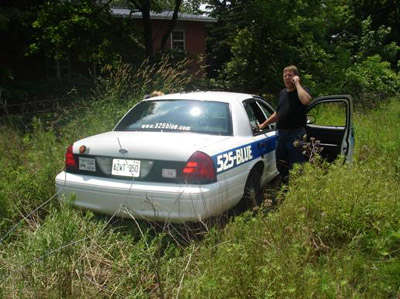
I was struck now by the sturdy look of serious action people have as they survey damage and call for help. I can't see him through the glass, but I can feel the presence of the driver, uninjured but speechless. I believe he spoke tenuous English at best, and was humiliated at having all these strangers around him.
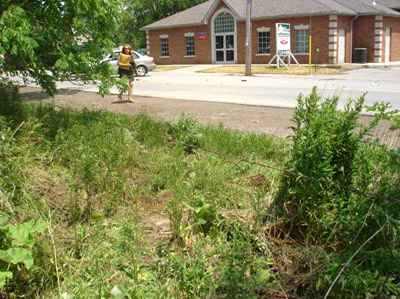
I was struck by people at the scene interrupted in their day. Shifted just slightly off course. Still holding the mundane objects that accompany daily tasks. Forced at an instant to cross the barbed wire into the brush.
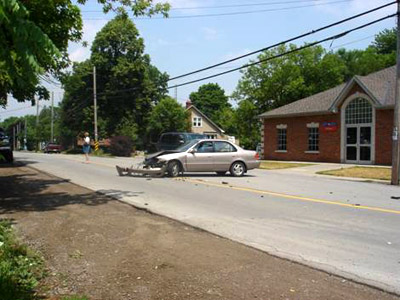
Those are the ones that react. After any accident there are also the people who are just bystanders, full of potential energy but stiller than statues. They could as easily be spectators in the Zapruder film.
Photograph bystanders in Dallas, 1963:
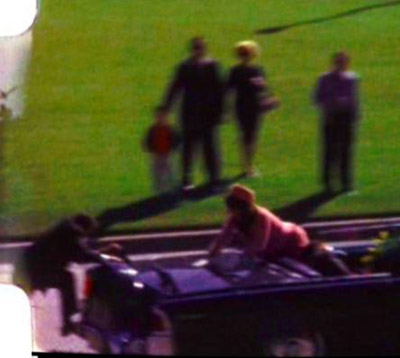
Abraham Zapruder, Frame 368 (detail)
or Mount Hope, 2007:
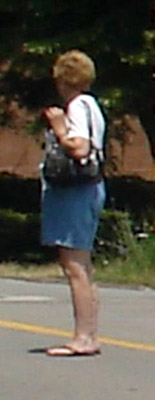
and they look the same - loaded with intent yet paralysed.
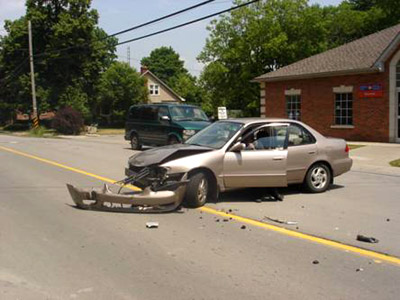
The Camry took it worse than the cab. I'm still struck by the fact that the driver reacted immediately, rushing to see that the cab driver was OK (that's the top of her head poking up above the driver-door in my photo of the taxi). I suppose she was shouldering a lesser burden of aftermath. That she had less at stake from an occupational point of view; less to lose from the careless driving demerits one can expect after an accident.
But then I didn't see everything leading up to the accident. The impact wasn't set in motion simply because I pulled in behind the cab. (I sure hope not anyway.) Both parties got up that morning and did certain things which put them on a collision course with each other. And each led a life up until that day which I know nothing about.
The cab driver was a recent immigrant. The 50 feet he travelled between hitting the Camry and stopping in the field were a small stretch of an ongoing journey, fortunately one that he's able to continue on.
In that sense the story has a happy ending, which is why I've kept these photos despite the fact that the authorities seem to have no further interest in looking at them or questioning me about what I saw.
Too bad. I'm sure the judge would have loved hearing me express the content of this essay in court.
By joejoe (anonymous) | Posted February 15, 2008 at 11:27:52
Mark,
I'm amazed to hear you were DRIVING!
QUESTION: How come you (usually) walk everywhere...?
By Mark Fenton (anonymous) | Posted February 17, 2008 at 15:18:39
Joejoe,
Thanks for your provocative question. I'd like to say my reasons for walking most places are purely environmental. In fact, the reasons are much more selfish. I find I don't see as much when I drive. Perhaps I'm willfully perverse, but in the midst of an accelerated society I think there's something to be said for there being people who move as slowly as possible. Although it drives people walking with me absolutely crazy.
Walking doesn't absolve me from suspicion though. I'm stopped by police officers when I'm on foot even more often than when I'm driving. So I guess my walking is more erratic than my driving. The camera doesn't help.
Once, just after I got my licence I had a job writing copy for the provincial government in Alberta. One of the things I was expected to do was deliver publications to the legislature. I didn't have a car at the time but my boss said, no problem, I could use his BMW for deliveries. It was his pride and joy this car.
I really, really didn't want to drive this machine he'd dreamed of owning for all of his adult life. But what could I say?
Anyway, I got there and angle parked and delivered my box. I'd driven standards before but never on a European car, and the BMW shift had this weird motion I later learned where you push IN and then OVER and DOWN for reverse. But I couldn't get it and I was stuck with the car pointing into a curb. This is why smart people BACK into the parking spot. That way if the car is a rental or stolen or whatever they don't get stuck if the reverse action requires a mensa level IQ to figure out. They just keep going and parallel park on an empty street.
All I could think of was putting the car into neutral and getting out and pushing it back. If you've been to Edmonton you'll know that the legislative building is on a hill and, of course, once the car got rolling it was less easy to stop than I'd thought and I lost control of it and had visions of it going all the way down the hill and destroying itself and probably hitting children or the elderly or something.
Thankfully it settled out harmlessly in a trough halfway down and no one seems to have seen me as I got in a drove away.
I coasted on that experience for a long time. When I was having a bad day I'd think of the BMW not getting wrecked and no one being killed and whatever was going wrong didn't seem so bad all of a sudden.
But after that I found I liked walking better. Even in extreme cold I walk if it's manageable and I hope this sets at rest some uncertainly you were having about what I'm like.
You must be logged in to comment.
There are no upcoming events right now.
Why not post one?